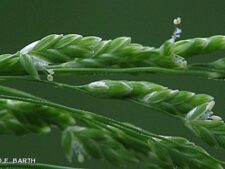
Rhizomatous native perennial with erect to leaning flowering stems up to 4 feet tall. Leaf blades are narrow, usually no more than 1/4 inch wide. The flower cluster is an open, nodding panicle up to 10 inches long bearing a large number of spikelets which extend nearly all the way to the base of the panicle branches (A). Each spikelet consists of several florets bearing 2 pale yellow stamens and a feathery, white stigma (D). Individual florets have lemmas with prominent nerves giving them a striated appearance (D).
Wet woodlands; wet ground along streams and ponds; freshwater wetlands. In Fontenelle Forest Fowl Mannagrass is uncommon in Child’s Hollow and along South Stream Trail. It is uncommon at Neale Woods on the banks of Rock Creek where it passes next to the Missouri River Ecology Trail. Flowering occurs from late May to July.
Nodding Fescue (Festuca subverticillata), which also has large drooping panicles, is usually found in drier sites, has a more open panicle, and has spikelets which are confined to the tips of the panicle branches. The panicle of Slender Wedgegrass (Sphenopholis intermedia) is dense and much narrower.
The content of NatureSearch is provided by dedicated volunteer Naturalists of Fontenelle Forest who strive to provide the most accurate information available. Contributors of the images retain their copyrights. The point of contact for this page is: Neal Ratzlaff.



